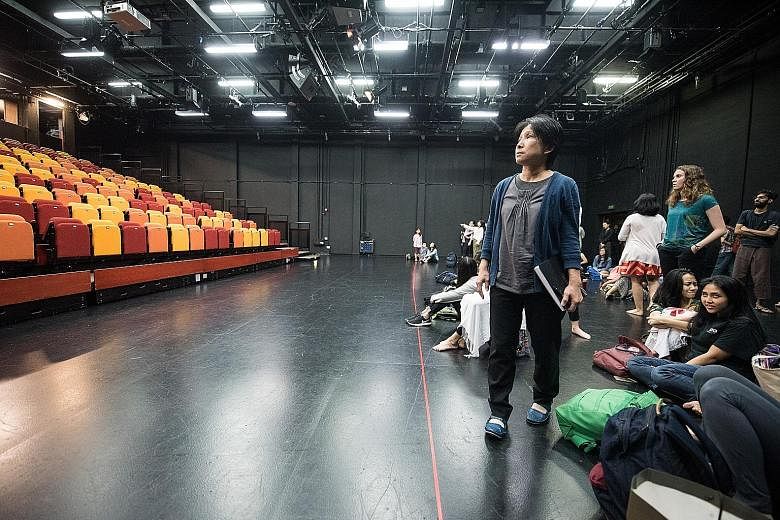REVIEW / THEATRE
OFFENDING THE AUDIENCE
Huayi - Chinese Festival of Arts
Esplanade Theatre Studio
Last Saturday
In 1966, Peter Handke's Offending The Audience broke theatre convention. Performers spoke directly to viewers more used to an invisible wall between ticket-holders and performers.
Singapore director Liu Xiaoyi similarly delights in challenging audiences. His experiments with time, space and the physical body are sometimes rewarding and sometimes boring and this commission for the Esplanade's annual Huayi festival splits the difference.
It starts with a pleasant picnic- like atmosphere. The bleachers are folded back and viewers sit on the floor.
Actors Li Xie, Nelson Chia and Oliver Chong walk around, banter and play catch with a cushion. Food and drinks are allowed. Chia even distributes crinkly snack packs that would infuriate classical music concertgoers if opened during the overture.
Then the three disappear. Only their voices are projected inside the studio as they and Liu discuss how to construct a "clean play", where real time and dramatic time collide.
It is an attempt to deconstruct theatre and have the audience create their own performance from the sounds and space provided. (Not a new idea, composer John Cage's 4'33" makes music out of a silent orchestra as the conductor turns pages.) It is an attempt that half-succeeds, yet also half-fails, because of the constraints of presenting this work in a theatre.
Viewers are told they can come and go freely. Yet, returning from a coffee run, one is barred from reentering for "safety" reasons as the studio space is overhauled.
Most ironically, all are kept away from the space where the performers are, even as the script denies the existence of a fourth wall.
After an hour of voiceovers and the occasional video projection showing the performers, viewers perk up as stagehands start pulling out the bleachers. But ticket-holders are barred from the very seats they paid for. Actress Ang Gey Pin steps out from the crowd to rail against this absurdity.
This is followed by 45 minutes of a predictable upending of theatrical tropes. The actor who was within the audience takes a seat, the audience watches from the space meant for the performance. Finally the line dividing both is erased and the hidden performers reveal themselves to the crowd's gaze.
Offending The Audience is a question asked by performers of themselves and to the audience. This is emphasised in the "post-show talk", where only phrases such as "I think" and "I want to say" boom from the speakers.
The question on the surface, brought up by Ang, is whether the ticket price is worth it.
The answer is subjective. It is difficult to offend audiences these days. It is far easier to bore them, to fail to make a connection with them.
Today's theatregoers are drawn to experiences. They are often already the star of their own personal theatre, highlights of which are shared on social media.
Offending The Audience offers nearly two hours worth of experience that can be shared real-time on social media. For some, this more than covers the ticket price. Or is that offending the theatre?


